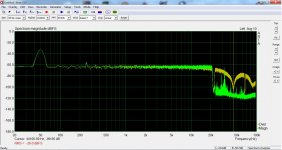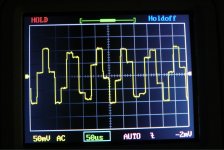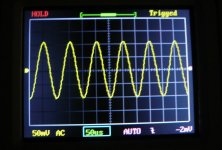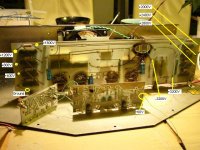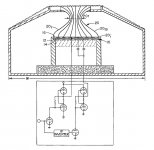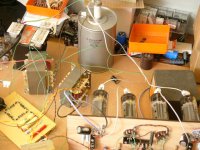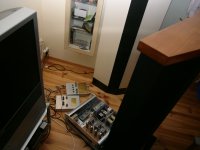The picture about NOS wouldn't be complete without reminding to Pioneer's legato link, which is essentially intentionally allowed "insufficient" filtering of images around multiples of the sampling frequency.
Afair Pioneer's argument was based (according to the litature from Pioneer) on listening test results, where participants always rated higher reproductions with content above 20 kHz even if this higher frequency content was somewhat artificially related to the content below 20 kHz.
I've never seen any technical description of the filter process, but it seemed to be kind of a downward sloping curve above 20 kHz, similar maybe to a sinc filter function.
Afair Pioneer's argument was based (according to the litature from Pioneer) on listening test results, where participants always rated higher reproductions with content above 20 kHz even if this higher frequency content was somewhat artificially related to the content below 20 kHz.
I've never seen any technical description of the filter process, but it seemed to be kind of a downward sloping curve above 20 kHz, similar maybe to a sinc filter function.
I had one... It didn't work very well (I stay diplomatic in my words). But there cd mechanism was the best ever with the disc you loaded in flipped position 🙂
"But there cd mechanism was the best ever with the disc you loaded in flipped position"
Until they all broke down...
The VRDS transports have superseded these (P-1, P-2 and P-10 etc.) in my setup.
Until they all broke down...
The VRDS transports have superseded these (P-1, P-2 and P-10 etc.) in my setup.
the VRDS was Pioneer based iirc or the name of it ? Well I am one of the first than took the no cd mechanism library for the best, I have still two Logitech Duet systeme on a shelf somewhere (sorry for the off topic)
the VRDS was Pioneer based iirc or the name of it ?
The VRDS is a TEAC drive.
Thanks, but OEM based on Pioneer's system iirc ? (Teac had more solid metal parts like the old CDM1 of Philips... I still have several mechanism of both on shelves)
Thanks, but OEM based on Pioneer's system iirc ? (Teac had more solid metal parts like the old CDM1 of Philips... I still have several mechanism of both on shelves)
You're right. There were several versions of the VRDS, including some featuring mostly plastic parts. The mostly metal versions, however, were extremely expensive. I don't know whether or not TEAC made any drives for Pioneer.
Last edited:
Bring it on !
I have the speakers to test it with (no XO, from subsonics up...)
In the top end i have added some super tweeters but these can be "switched off"
Frank, since you have fullrange speakers, you could try RC low-pass filtering the signal to your power amp, maybe around 5KHz, to try MagicBus' experiment. It would only be a shallow 1st order slope, however.
With the super tweeters disconnected of course.
Last edited:
I will see what i can do. I will need 2 identical cd players, one with filter and one without. My dac has 2 SPDIF inputs and can only be used mono (dual mono) so it can not be used for this experiment. As all is balanced i will need a transformer (that is actually a good thing here).
I will see what i can do. I will need 2 identical cd players, one with filter and one without. My dac has 2 SPDIF inputs and can only be used mono (dual mono) so it can not be used for this experiment. As all is balanced i will need a transformer (that is actually a good thing here).
Okay, whatever is convenient. I want this to remain fun, and not become a chore.🙂 I suspect that this tweeter experiment will confirm that we need to look toward the OS digital reconstruction filter next anyhow. I expect that we'll begin discussion regarding that by Monday.
I had some time to put it all together in working order! And I made a temporary output selector with "remote control" 😀 So I can perform AB test from listening position without playback interruption. Not breath taking findings so far regarding OS vs NOS, otherwise the DAC sounds glorious. I need to spend a little more time with it. I believe I should have something to post by evening.
Attachments
Time to report! First of all, my DAC was rebuilt and this resulted to a general upgrade that could easily fool me if it wasn't the setup mentioned above... Before anything, I took some basic measurements not calibrated, just for comparison. Frequency response and 10kHz sine NOS vs OS. No, they do not make big difference soundwise, at least in my system... Especially with tweeters disconnected mostly you can tell that the output switched by the relays' "click". My system - the "magic bus"- is fully DIY and it is built to satisfy my preference for a big, articulated sound stage. I'm so familiarized with this that I can detect any change, yet switching from NOS to OS I can't see anything happening. Maybe a subtle difference for content around 1kHz, not for more lower or higher frequencies, which becomes just a bit easier to follow with the tweeters on again. More easier with headphones. But then another problem comes in: there is not much music above 10kHz and I would dare to say even 8kHz. So I thought to use a test CD -Alan Parsons and Stephen Court-Sound Check. With a sine, the real threshold of audible droop is at 12kHz and the even more real limit of my 50 years old ears is around 16kHz... What works better to spot the difference is complex signal, white noise and square wave but only around 1kHz!
I wouldn't like to lead to false conclusions with my subjective opinion. Let alone I've only spent a few hours with it. But I'll put it to your judgement. I feel that both OS and NOS equally provide "info" about the recorded event but each one on its own way. OS does it with frequency content if that tells anything to you. Equalized sound so to speak. Not to underestimate, very good sound. NOS does it in a dynamic way that lets you know something is pulsating there... OS vs NOS looks like sound vs energy. I still like NOS!
I wouldn't like to lead to false conclusions with my subjective opinion. Let alone I've only spent a few hours with it. But I'll put it to your judgement. I feel that both OS and NOS equally provide "info" about the recorded event but each one on its own way. OS does it with frequency content if that tells anything to you. Equalized sound so to speak. Not to underestimate, very good sound. NOS does it in a dynamic way that lets you know something is pulsating there... OS vs NOS looks like sound vs energy. I still like NOS!
Attachments
Great info ! Thanks !
I would like to know if you have some complex choir music to compare. This for me is always a reference as individual voices can be heard (naturally the recording has to be of good quality).
WEINBERG, M.: Symphony No. 8, Op. 83, "Tveti Pol'shi", "Kwiaty Polskie" (Polish Flowers) (Dobrowolska, Marciniec, Bartminski, Wit) - 8.572873
I would like to know if you have some complex choir music to compare. This for me is always a reference as individual voices can be heard (naturally the recording has to be of good quality).
WEINBERG, M.: Symphony No. 8, Op. 83, "Tveti Pol'shi", "Kwiaty Polskie" (Polish Flowers) (Dobrowolska, Marciniec, Bartminski, Wit) - 8.572873
I know what you mean! I did try some from my music library. The following days I' ll have the chance to listen to more.
I will see what i can do. I will need 2 identical cd players, one with filter and one without. My dac has 2 SPDIF inputs and can only be used mono (dual mono) so it can not be used for this experiment. As all is balanced i will need a transformer (that is actually a good thing here).
Frank, it occurs to me (it should have occurred to me sooner) that your fullrange drivers likely have a fair degree of suppression above 20KHz. Therefore, they will deliver a fairly good acoustical filtering of the image-bands without tweeters to disconnect. Which would then mean that you probably don't need to insert any low-pass filter in order to try the MagicBus experiment, if you wish to. No worries if you don't manage to get to it. Keep having fun.

Actually i have never measured the speakers on the "range". Beware that i do not use any transformers so the frequency limit is not as you could expect from a "regular" ESL.
Attachments
Last edited:
- Home
- Source & Line
- Digital Line Level
- What do you think makes NOS sound different?

